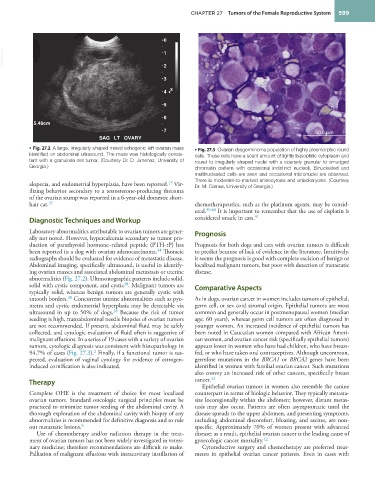Page 621 - Withrow and MacEwen's Small Animal Clinical Oncology, 6th Edition
P. 621
CHAPTER 27 Tumors of the Female Reproductive System 599
0
VetBooks.ir 1
2
3
x
4
5
6
5.48cm
7 50.0 m
SAG LT OVARY
• Fig. 27.2 A large, irregularly shaped mixed echogenic left ovarian mass • Fig. 27.3 Ovarian dysgerminoma population of highly pleomorphic round
identified on abdominal ultrasound. The mass was histologically consis- cells. These cells have a scant amount of lightly basophilic cytoplasm and
tent with a granulosa cell tumor. (Courtesy Dr. D. Jimenez, University of round to irregularly shaped nuclei with a coarsely granular to smudged
Georgia.) chromatin pattern with occasional indistinct nucleoli. Binucleated and
multinucleated cells are seen and occasional micronuclei are observed.
There is moderate-to-marked anisocytosis and anisokaryosis. (Courtesy
15
alopecia, and endometrial hyperplasia, have been reported. Vir- Dr. M. Camus, University of Georgia.)
ilizing behavior secondary to a testosterone-producing thecoma
of the ovarian stump was reported in a 6-year-old domestic short-
37
hair cat. chemotherapeutics, such as the platinum agents, may be consid-
ered. 39,40 It is important to remember that the use of cisplatin is
41
Diagnostic Techniques and Workup considered unsafe in cats.
Laboratory abnormalities attributable to ovarian tumors are gener- Prognosis
ally not noted. However, hypercalcemia secondary to tumor pro-
duction of parathyroid hormone–related peptide (PTH-rP) has Prognosis for both dogs and cats with ovarian tumors is difficult
34
been reported in a dog with ovarian adenocarcinoma. Thoracic to predict because of lack of evidence in the literature. Intuitively,
radiographs should be evaluated for evidence of metastatic disease. it seems the prognosis is good with complete excision of benign or
Abdominal imaging, specifically ultrasound, is useful in identify- localized malignant tumors, but poor with detection of metastatic
ing ovarian masses and associated abdominal metastasis or uterine disease.
abnormalities (Fig. 27.2). Ultrasonographic patterns include solid,
solid with cystic component, and cystic . Malignant tumors are Comparative Aspects
38
typically solid, whereas benign tumors are generally cystic with
smooth borders. Concurrent uterine abnormalities such as pyo- As in dogs, ovarian cancer in women includes tumors of epithelial,
38
metra and cystic endometrial hyperplasia may be detectable via germ cell, or sex cord stromal origin. Epithelial tumors are most
ultrasound in up to 50% of dogs. Because the risk of tumor common and generally occur in postmenopausal women (median
38
seeding is high, transabdominal needle biopsies of ovarian tumors age: 60 years), whereas germ cell tumors are often diagnosed in
are not recommended. If present, abdominal fluid may be safely younger women. An increased incidence of epithelial tumors has
collected, and cytologic evaluation of fluid often is suggestive of been noted in Caucasian women compared with African Ameri-
malignant effusions. In a series of 19 cases with a variety of ovarian can women, and ovarian cancer risk (specifically epithelial tumors)
tumors, cytologic diagnosis was consistent with histopathology in appears lower in women who have had children, who have breast-
94.7% of cases (Fig. 27.3). Finally, if a functional tumor is sus- fed, or who have taken oral contraceptives. Although uncommon,
2
pected, evaluation of vaginal cytology for evidence of estrogen- germline mutations in the BRCA1 or BRCA2 genes have been
induced cornification is also indicated. identified in women with familial ovarian cancer. Such mutations
also convey an increased risk of other cancers, specifically breast
Therapy cancer. 42
Epithelial ovarian tumors in women also resemble the canine
Complete OHE is the treatment of choice for most localized counterpart in terms of biologic behavior. They typically metasta-
ovarian tumors. Standard oncologic surgical principles must be size locoregionally within the abdomen; however, distant metas-
practiced to minimize tumor seeding of the abdominal cavity. A tasis may also occur. Patients are often asymptomatic until the
thorough exploration of the abdominal cavity with biopsy of any disease spreads to the upper abdomen, and presenting symptoms,
abnormalities is recommended for definitive diagnosis and to rule including abdominal discomfort, bloating, and ascites, are non-
out metastatic lesions. 9 specific. Approximately 70% of women present with advanced
Use of chemotherapy and/or radiation therapy in the treat- disease; as a result, epithelial ovarian cancer is the leading cause of
ment of ovarian tumors has not been widely investigated in veteri- gynecologic cancer mortality. 42
nary medicine; therefore recommendations are difficult to make. Cytoreductive surgery and chemotherapy are preferred treat-
Palliation of malignant effusions with intracavitary instillation of ments in epithelial ovarian cancer patients. Even in cases with

